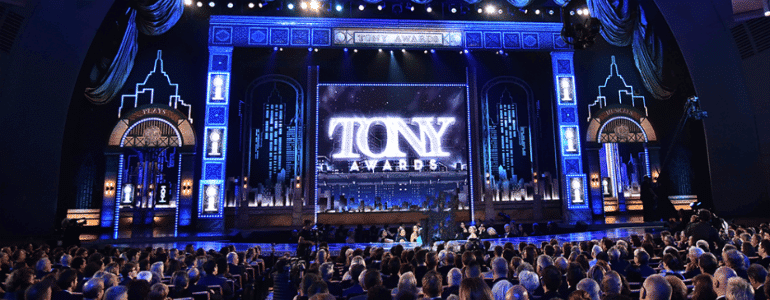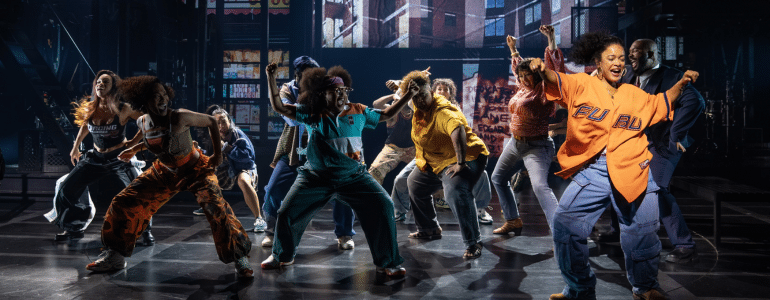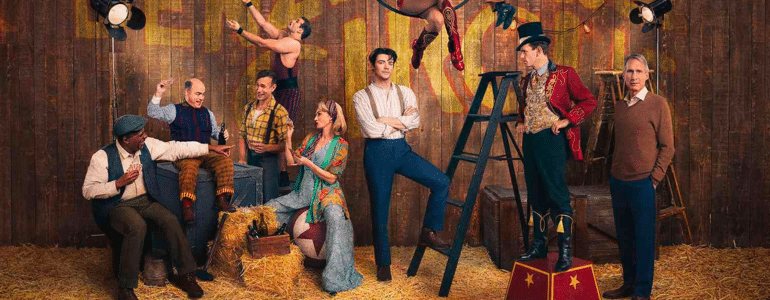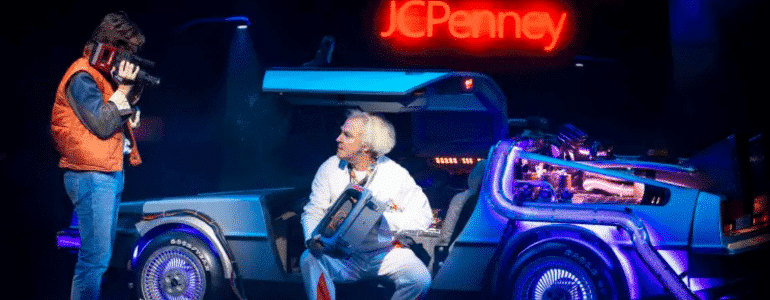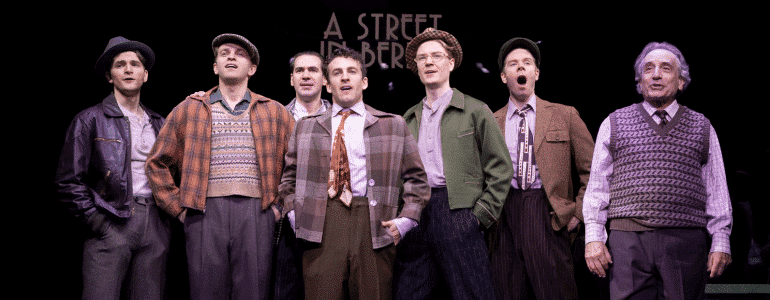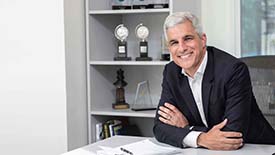Podcast Episode 42 Transcript – Casey Nicholaw
Ken: Hello, everybody, Ken Davenport here. Welcome back to The Producer’s Perspective Podcast! Now, before I introduce today’s guest I have to tell you a little story. As you all know, I talk to lots of theatergoers . . . at my own shows, on the subway, when I see people holding Playbills . . . and the other night I approached a couple from Georgia who I saw holding a Playbill and they said they were in town seeing some shows and I asked them what shows they were seeing and they said, “Oh, we’ve seen three shows. We saw Book of Mormon,” yes, you’re laughing already. You know what’s coming. “Book of Mormon, Something Rotten! and Aladdin.” Of course they loved them all, and what do all three of these shows have in common? Well, all three were directed and choreographed by the man who is here to talk to you today. Welcome to the podcast Tony Award winner Casey Nicholaw. Welcome, Casey!
Casey: Thank you. Hi, everyone!
Ken: I swear that is an absolutely true story, and thank God she loved them, because that really would have been awkward.
Casey: Thank God. I wouldn’t have let you start with that. “We really liked two of them. Two of them were so good!”
Ken: It is crazy, though, when you think about it. You have these three mega-million dollar club shows on Broadway right now. You have a bit of a divining rod for finding these hits, as well as making them into hits. What do you think is the secret ingredient to that?
Casey: I have no idea, actually. I mean South Park is a big ingredient of Book of Mormon and Aladdin is a big ingredient of Aladdin. Something Rotten! is just a show that totally appealed to me when Kevin McCollum brought it to me, and it’s just been a labor of love. We absolutely love the show.
Ken: I always bring you up as an example of directors and choreographers who you should look for, because even when you go back further, Drowsy Chaperone, which was your debut as a director . . . Spamalot was a hit . . . in fact if you look at your Playbill Vault list there are seven shows that you’ve done in the commercial Broadway arena, and it looks to me like five have been commercial successes. Your recoupment rate is outstanding.
Casey: Pretty awesome.
Ken: So, tell me . . . I do believe you have an innate sense, whether you know it or not, of what the audience that goes to Broadway shows want to see. What do you look for specifically or what attracts you to shows?
Casey: Something that’s buoyant. Actually something that I’m going to want to see is sort of what I look at. I look at a show and I go, “I would love to see something like this.” It’s a combination of that, but it’s also a combination of the storytelling of it. If it feels like it’s a good story or it’s a good script and it’s something that interests me, that has like a buoyant build to it, which all of those three shows do have in common . . . the storytelling is fantastic in those shows.
Ken: You mentioned the shows that you would want to see. Tell me a little bit about how you got into the theater in the first place, where it all began.
Casey: It all began in San Diego, really. My parents were not from a theatrical background and they just saw that I was interested in that. I think that’s when I sort of found myself as a young kid. 13 years old and I was suddenly a dancing Indian in Annie Get Your Gun in San Diego, in junior theater there, and made new friends because high school was not for me and junior high school was not for me. I just felt like such a misfit . . . bad at sports, made fun of, all of that kind of thing . . . and then I found my theater family. That was great, finding a place to fit in in that way.
Ken: Then you made the move to New York City to become a performer here?
Casey: Yeah, but it sort of started earlier back in San Diego because I did a show at the Old Globe when I was 15 with Gregg Barnes, who was in it as well, and Brian Stokes Mitchell was in it and Kathy Najimy was in it. I learned so much from being in that situation and I just knew that I wanted to move to New York. I stayed at UCLA for about a year and a quarter and then I was like, “I’m outta here,” basically, because I just knew I wanted to be here.
Ken: So you got here and what happened next?
Casey: I got here and I waited tables for a really long time. I came as a performer, I had $50, nowhere to live, slept on people’s couches, which you kind of could do then, waited tables absolutely everywhere, watched all of my friends get their Equity cards, lost my hair. Once I lost my hair, then I started working.
Ken: Really?
Casey: Absolutely. I couldn’t get jobs at all but you know, it’s those formative times. I sort of developed my sense of humor when I lost my hair. It was a very self-deprecating sort of sense of humor, but I wanted to be the first to talk about my hair loss before people started commenting on it. Everyone was looking at my forehead when they were talking to me, like, “Hey, I haven’t seen you in a long time, great! How are you?” And their eyes are just focused on the top of my head. Then I started getting into the ensemble of all of these shows and I was always the waiter or the gangster or the stagehand, all of those parts, but I loved it.
Ken: First Broadway show?
Casey: Crazy for You.
Ken: Crazy for You, what a great show that was.
Casey: Awesome. It was everything you could ask for, for someone who grew up loving MGM musicals. When I was growing up we didn’t have VCRs or we were just getting Beta, so I was always going to the revival houses, checking the schedules, having to drive to the theater to get the schedule, and circling the ones I wanted my parents to drive me to so that I could go see all of the old musicals.
Ken: How many shows did you do as a performer on Broadway?
Casey: Eight.
Ken: Eight. So when did you start to think that you wanted to be on the other side of the proscenium?
Casey: I just paid attention to all of it. I’ve always wanted to do it. I actually choreographed a lot, non-Equity, before I started concentrating on performing. Like during the losing-my-hair period I was choreographing non-Equity, and then I just decided after a while I wanted to get back to it. I’ve told this story so many times now but, for those of you who have not heard it, I was in Seussical and I just really wanted to do something more, and so I rented some studio space and I said, “I’m just going to be creative,” and I went to New Dance Group every Wednesday and Saturday between shows and I was like, “I’m going to be creative!” I wasn’t very creative to start with. I was like, “I don’t know what I’m doing. Why am I here? What do I want out of life?” And then, before you know it, I choreographed three numbers, had 25 dancer friends . . . thank you everybody . . . who did this with me. I arranged three numbers and I invited every writer, director, producer that I had worked with in those eight Broadway shows. And everyone came and Kevin McCollum gave me a job choreographing The Prince and the Pauper for Ordway and 5th Avenue, and that’s kind of what started it. Then I did Dance Break. I don’t know if they still even do it, but I did Dance Break and then Des McAnuff hired me to do the Sinatra show at Radio City.
Ken: So your choreography career starts going well. You do Spamalot, a big fat hit, and then Kevin McCollum, again, says, “Hey, do you want to direct Drowsy Chaperone and choreograph it?”
Casey: Right.
Ken: Did you have, “Oh, that’s the next step for me. I’m going to do that?”
Casey: I just said, “Sure!” and then it happened. I met with the writers of Drowsy the morning after Spamalot opened and they were like, “Do you want to do this?” and I was like, “Yeah!”
Ken: And you jumped right in? Were you nervous about it?
Casey: It was a very different show then, when I came on board. I knew I loved it and it made me laugh and stuff, but it didn’t have the physical production that the Broadway show ended up having. It wasn’t set in someone’s apartment. It was a chair on the side and there were six doors and people came in and out of the doors and did these period songs while the man in the chair basically deconstructed it all. But they were doing that show with very little money, so that was their set. In their heads it probably was, but we made it a real, physical place to then disappear into this musical theater world.
Ken: That brings up an interesting question. When do you like to start working on these new shows?
Casey: I like getting in as soon as I possibly can. When I got involved with Drowsy they had done it in Toronto already, and then they did a NAMT 45-minute version of it and then they brought me on board and changed it a lot. We changed it a lot. We cut six songs right off the top, moved all kinds of stuff around. They’ll be the first to tell you that they hadn’t really thought of the dance element in that way because there wasn’t a dance element, really. We changed the opening number, we gave it more of a ’20s feel as opposed to it was a little bit more of the operetta world when we started.
Ken: I agree with you. I don’t think writers think about dance at all sometimes.
Casey: No.
Ken: When I read musicals . . . they just don’t visualize it. They stare at text all day.
Casey: Right.
Ken: And, of course, some of the greatest Broadway directors we’ve ever had have been choreographers first, from Fosse, Bennett, Jerome Robbins . . . why do you think choreographers make great Broadway directors?
Casey: One is I think it’s one vision, which is a great thing because with two people there’s more chance of them not getting along or having a different vision. A musical has to move, literally, with pace, and so I think a choreographer knows pace well and is able to keep things moving. Especially for me, the shows I’ve been doing, the comedies. It just has to go, and there’s a natural build that has to happen in a musical, and I think that a choreographer is also very helpful with the transitions, so someone who is directing and choreographing can move things literally more quickly.
Ken: So Book of Mormon obviously exploded onto the scene several years ago now, but the buzz was deafening about that show. What I loved about the advertising campaign that Scott Rudin initiated back then was that you didn’t really see much of the show in any of the advertising.
Casey: He was very smart.
Ken: So smart, because it just made you want to get in there that much more. When you did the workshop for that . . . there was a workshop . . . was it supposed to go to New York Theatre Workshop first?
Casey: I think so. I was actually brought on pretty late, because they had been working on it for five or six years and I was brought in as new eyes. Then we did a lab three weeks after I got hired and then it went to Broadway from there.
Ken: At the final performance of the lab, did you know what it would become? Were you like, “Oh, this is going to be special?”
Casey: We knew we had something special, absolutely. I didn’t know it when I started for sure, and I was also petrified, so I didn’t know, and this was people who had been working on it already and I was just really nervous about it all, but then you just got this feeling. And it was that feeling that when I had friends come to the workshop, they said after it, “Oh my God, that was amazing. I loved it,” and then they texted me later that night. “I can’t stop thinking about that.” And then two days later calling me and saying, “I just have to say, I have not stopped. I still have that song stuck in my head,” or, “I still am thinking about this moment.” So that’s three times, as opposed to someone just going, “That was cute,” or, “That was sweet,” or, “Fun.”
Ken: “Cute” is the worst.
Casey: “Cute” or “sweet” is the worst, absolutely the worst. I just want someone to say, “That was so funny,” or, “I loved it.”
Ken: I did a show Off-Broadway several years ago and I always hang out at the entrance to the theater and I heard four people say it was cute after the third preview and I was like, “Nope, not going to make it.”
Casey: Yeah, totally.
Ken: Shows don’t make it on “cute.” You need much more passionate word of mouth. So tell me a little bit about your process. You get a call and it’s like, “Hey, we need fresh eyes on Mormon,” or you get a call about Drowsy Chaperone. What’s the first thing you do? Are you a research guy? Do you go to your studio?
Casey: It depends which hat I’m wearing, if I’m wearing the director hat or the choreographer hat. If I’m wearing the director hat it’s all about the script to start with, so getting the storytelling right, deciding which songs are going to build just as strongly as the script builds, because the song structure is so important in it. It has to build and it has to be the right balled next to this, or you’ve got three ballads in a row so it’s just going to tank here. It really is dictated by that, I think. All the time, dealing with writers . . . we were talking about this the other day as we were working on Tuck. Writers say, “It’s an energetic scene so it sort of acts like a song.” No, it really doesn’t. It really doesn’t. If there’s not a song in it, it doesn’t act like a song. People know. It’s like three pages, song, three pages, song, three pages, song. It’s like the encores rule. And also, it’s a pretty good rule to follow anyway because then, if you’ve got 13 pages in between two songs, the show is going to lag. It totally is, and you have to figure it out, you have to restructure it somehow. There’s always a moment in a show, like in Aladdin, actually. We suddenly realized we don’t have a production number in the middle of act one, and we need one. And we completely changed “Babkak, Omar, Aladdin, Kassim,” which was just a small, cute number . . . “cute” number . . . with the four guys, and it just didn’t go anywhere and it was like song number three in the show, so we pulled it out and we made it a giant production number in the middle so that we had major ensemble buoyancy in between “Arabian Nights” and “Friend Like Me.”
Ken: So let’s talk about Aladdin a little bit, which is obvious a big fat hit here. But when you did the tryout in Toronto there was all of this scutter, like, “Oh, maybe it’s not working. Maybe it’s not working.”
Casey: “Maybe it’s a turd.”
Ken: I love your bluntness. I would never say that.
Casey: Honestly, I was saying, “This can’t be a turd, this can’t be a turd.” I just kept saying that. And it was feeling like that. And everyone just completely rallied. I went into killer mode and I kept talking to Natasha Katz, like, “I’m going into killer mode now,” and she was like, “Alright, go killer!” And Tom and Anne, everyone was so supportive of it, saying, “This is what we need to do.” I suddenly got, “I know what to do,” and I would do it. And we all worked together and it was a really supportive atmosphere and we were able to . . . Chad . . . everybody was just champs. “Let’s cut numbers, give numbers to other people.” The thing about Aladdin is that it was originally conceived as this musical theater movie that ended up being an action adventure, and part of the conceit of the musical theater part of it was that Babkak, Omar and Kassim narrated the whole story, so we thought, “Perfect!” and we used all the stuff that Howard and Alan had done with those three guys narrating and we realized that it was a mistake, and so we took “Arabian Nights” away from those three guys and they were great about it, and gave it to the genie, because we didn’t see the genie for 45 minutes into the show, which is kind of what happens in the film as well, and then we were stuck with, “Okay, if we’re cutting all that, what do we do to change the set?” Because every time we had to change the set, those three guys did that, so we ended up . . . maybe not ideal . . . but we ended up getting a brand new drop that was a palace hallway drop and doing half of every scene in front of it. So we had to do a lot of thinking and a lot of re-choreographing and a lot of rejigging and it really ended up well.
Ken: What percentage of it changed from Toronto to Broadway?
Casey: I would say about 30%.
Ken: That’s a lot.
Casey: It is a lot, but I would say about 30%. We worked really hard during that time. Everybody worked really hard, every department.
Ken: I wrote a blog a long time ago that I think where creative team members earn their stripes is during a preview period or during a tryout, because people don’t realize that you’re working under the confines of stagehand hours and scenery. You had a set built, it wasn’t like you were going to trash it and build a whole new one, so you had to rewrite the story around the preexisting set.
Casey: Absolutely.
Ken: Obviously you did incredible work. I love the “killer mode” idea. It’s certainly what you need to do. How do you get feedback during that? Do you listen to audience members during previews? Was it just your own gut saying, “This is a turd?”
Casey: Usually it’s my own gut. And audience response, of course. I watch half the show looking up and down the rows. But mostly it’s my gut. Again, it’s the thing I said earlier. It has to be a show I want to see, and I wasn’t really enjoying myself at Aladdin when I was watching it so I thought, “Well something’s wrong. If I’m not looking forward to the next number then it’s not right.”
Ken: Was it surprising to you, that first preview? Were you like, “We’re in good shape!”
Casey: It was, it was. And also we were in Toronto and you start going, “Well, is it the audience here? Would it be the audience in New York? Is it a Canadian versus New York thing?” You just don’t know, you start questioning everything. But then you have to really listen to your gut. I’m not Canadian and I wasn’t enjoying it. You know what I mean? There were so many moments I loved in it, but we all knew it and I think we all felt it, you could sort of tell. You can sort of tell in actors a little bit too, when they start getting a little disgruntled about things and you go, “Okay, maybe things aren’t so good.” You just have to watch everything for signs, you really do.
Ken: So we talked a little bit about how you prepare as a director. How do you prepare as a choreographer? You get, “Here’s a big dance number I have to do.” What’s the first step in creating that number?
Casey: Well actually it’s even before that. You get a song and you don’t know what it’s going to be and then I’m like, “Hey, I think this should be a big dance number,” so it sort of starts there, and then the next thing is always Glen Kelly or David Chase . . . but, for the most part, Glen is the person I’ve worked with the most . . . and so I’ll say to Glen, “I want a big dance number here,” and he’ll just go and write something and then we’ll start working together. I’ll say, “Oh my God, I love this part of it,” and he inspires me so much. He is just one of the unsung heroes of bringing all of the shows that I work on to life. And many people . . . Susan Stroman, Warren Carlyle . . . they use Glen, and he is absolutely fantastic. So then it goes with that, and then I basically sit on the floor and close my eyes and watch it like a movie a million times while Glen’s playing it and see what I want to see and see where it lags and see where I need more and then, after that, I’ll get my associates, which, for those three shows we talked about, John MacInnis has been the associate choreographer, and then you know Jen Werner and Steve Bebout and Scott Taylor have been the associate directors, and we’ll go in a room with Glen and, for a week, just try to start staging the numbers and then we’ll get six dancers or something and put all the numbers together with those people.
Ken: I actually never even thought about that. If you think about it in terms of writing music first or lyrics first, so your dance numbers are music first.
Casey: Absolutely. For me. I don’t think everybody works that way. I don’t know if everyone works that way, but that’s it for me.
Ken: And so many of the numbers that you’ve done have so much comedy in them, especially the Mormon stuff, of course, and Chaperone. Does that just come out of that movie in your head? Do you improvise with the dancers?
Casey: It does come out of my head in that way and also, to me, it has to stay true to the feeling of the show, because if you’re doing a big comedy, if you’re doing Book of Mormon, the numbers have to be funny too. You can’t just stop and do a dance number for no reason, just to have energy. You can a little bit more in Aladdin. It doesn’t have to be as funny unless it’s the genie, who’s a funny character. But Something Rotten! and Mormon both have to have those hooks, and Drowsy did too.
Ken: So you have three big fat hits here in New York. You have another show coming up. But, in addition, some of these shows, of course, are all over the world now. Book of Mormon in London, Aladdin I’m sure is going to be super global. I think what a lot of people don’t realize is that your job is not over after opening night.
Casey: No, it’s not.
Ken: How much of your time do you spend maintaining these shows?
Casey: Quite a bit. I return to the shows quite often, and also when there are understudies going on or there’s a cast change or something, just to make sure that the show stays in as good shape as possible. It gets difficult after four years with a show. It’s great, but it’s a lot and I just want to make sure I’m still involved in keeping everything in as good shape as when it started.
Ken: Tell me a little bit about Tuck, the next show that opens this year for you.
Casey: It’s a beautiful show, it really is. I love it. Claudia Shear and Nathan Tysen and Chris Miller are the author, composer and lyricist and it’s a really beautiful, heartwarming story. It was written in . . . I forget exactly which year . . . but in the ’70s to help younger kids/early adults to deal with life and death. And it’s a story about a family that lives forever, and if you had that choice, would you? And what the circle of life is. It’s a beautiful story.
Ken: It’s not a big fat musical comedy.
Casey: It is not at all, it really isn’t, but I was so drawn to the humanity of it.
Ken: What else is coming up for you? I had John Breglio on this podcast a few weeks ago and he broke the news that you would be doing Dreamgirls in London.
Casey: Correct.
Ken: So how did that come about?
Casey: I am so excited. I’m just so excited. I don’t know if I’m supposed to but the news has already broken, I guess, and we have auditions in London so I guess people know it’s happening. Sonia Friedman, when I was at the Oliviers during the Book of Mormon year, said, “I have the rights to this. Would you be interested in doing this?” I was like, “Are you kidding me?” It is seriously my favorite show. I moved to New York in 1982, I stood for it six or seven times. I love it, absolutely love it, and I am so excited. And it’s never been done in London, which is one of the cool things about it.
Ken: So you’ve worked for some of the best and most powerful producers in the business, from Scott Rudin to Kevin McCollum to Disney, of course. Tell me a little bit about what you like a producer/director relationship to be like. Without naming who’s your favorite.
Casey: I think my favorite producers to work with . . . the best thing is we all meet, they trust me and then the thing is they have opinions and then they leave me alone during the rehearsal process and then they’re able to be fresh eyes and have lots to say. They’ll come after an act one run or an act two run when we’re doing the runs in the studio but once we go into previews, that’s when it’s most helpful to have that person really weigh in with us.
Ken: Advice for people that want to do what you do, that want to direct and choreograph?
Casey: Honestly, just make it happen. Figure out a way to do it and work really hard. It’s a different thing for me because I didn’t end up being an associate or anything first, but I think that part of my work ethic as a performer and my experience being a performer in Broadway shows let people know that I was reliable and had a sense of humor and that kind of thing before I started doing this.
Ken: Any shows that you want to do? Your dream list, besides Dreamgirls.
Casey: Except for Dreamgirls everything I’ve done has not been a revival, it’s been something original. The big one on my list was Most Happy Fella and I got to do it at Encores! the year before last. The other one for me is Me and My Girl, which I’ve always wanted to do.
Ken: What about writers? The South Park writers coming to Broadway, of course, was a very exciting thing for all of us and any time someone very successful from the other coast, if you will, or from somewhere else, it’s exciting for us. Any other writers that you think would have a great Broadway musical in them?
Casey: I don’t know offhand. I’ll have to think about that and I think I don’t want that in here.
Ken: Okay, last question, which is perfect for you because I ask every single person on my podcast this question and it’s now been called my genie question.
Casey: Okay.
Ken: I want you to imagine that the genie from Aladdin that you helped create for the Broadway production.
Casey: You ask everyone this?
Ken: Every single person.
Casey: I love it!
Ken: Including Tim Rice. And you gave this genie another song, so he knocks on your door and says . . .
Casey: Do I get four of them?
Ken: No.
Casey: Okay.
Ken: The genie says, “Thank you for giving me that extra song and for helping to make Aladdin the big fat hit that it is instead of the turd it could have been. I’m going to grant you one wish.” What is the one thing that drives you so crazy about Broadway, that keeps you up at night, that makes you so angry that you would ask this genie to wish away with the snap of a finger?
Casey: It’s a tricky thing. I wish that there wasn’t just one winner of a Tony Award. That’s what I wish. I understand it’s about money and that that has to happen, but I just wish that it wasn’t so reliant on that that a show could succeed or fail and that there would be room for more in that way.
Ken: Great answer. Michael Brandon just gave an interview recently where he said that Broadway, unlike the West End, is too focused. It’s all about Tony Awards. That’s all we do. From the start of the season, everyone handicaps it. “Who’s going to win?” Because that’s all that we seem to care about, instead of just doing great theater.
Casey: Honestly, too, I don’t know this because I’m not in marketing or anything, but I don’t know that the rest of the world outside of New York worries about that as much. We do because it’s about getting the rest of the world in, but I don’t know that they do.
Ken: I think you’re right. The same thing with reviews, frankly. I think it’s our own ego that we’re trying to serve, more than the audience.
Casey: If someone comes and they’re only going to see one show, they want to know which the best one, by definition of winning an award, is.
Ken: I want to thank you so much for spending the time with us.
Casey: Absolutely.
Ken: I know you’re very busy, you’ve got to maintain all of these shows around the world. And thank you for your contribution to the theater, you have an unbelievable track record and it’s really something we can all learn from, so thank you for sharing your wisdom with us.
Casey: Thank you.
Ken: Thanks all of you for listening. We’ve got another director next week . . . we have the original director of Les Mis, Mr. John Caird, joining us. So tune in then. Don’t forget to subscribe and thanks so much!
Podcasting
Ken created one of the first Broadway podcasts, recording over 250 episodes over 7 years. It features interviews with A-listers in the theater about how they “made it”, including 2 Pulitzer Prize Winners, 7 Academy Award Winners and 76 Tony Award winners. Notable guests include Pasek & Paul, Kenny Leon, Lynn Ahrens and more.







